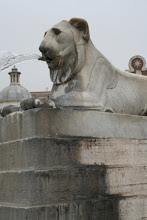When the Emperor Nero built his Domus Aurea, or Golden House
in 64 AD, Rome had recently undergone a great blaze that wiped out villas and
houses on the Caelian Hill. Rumour had
it that the fire had been deliberately started (hence “Nero ..fiddled while
Rome burned”) although today this is disputed by historians. Whatever did enable Nero to reclaim large
tracts of land in the centre of Rome – the Domus Aurea covered some 100 acres –
he built a lavish colonnaded structure, with mosaic ceilings inlaid with
precious stones, rooms faced with marble and wonderful frescoes. There was, according to scholars of the day,
an ingenious dining room open to the sky, with a revolving fretwork ceiling that
rained rose petals and perfumes down on the guests. Formal gardens and parks spread as far as the Palatine Hill. A huge bronze statue of Nero, over 100 feet
high, stood at the entrance to the Domus Aurea, representing the emperor as a
sun god.
 |
| The entrance to the Domus Aurea today |
Nero committed suicide just four years later in 68 AD, after
the Senate declared him a public enemy. He
was 30 years old. What followed was the Damnatio memoriae, a complete
eradication of Nero’s works. The Domus
Aurea was stripped of its treasures, it
was filled with earth and the public baths, the Baths of Titus, were built over
the villa. The pleasure lake of the
Domus became the site of the Colosseum.
The Domus Aurea remained buried until the 15th
century, when a young Roman fell through the earth into an underground grotto
filled with wonderful frescoes. Soon
the renaissance artists were letting themselves down on ropes into these
underground caves to study the paintings and later, copy the techniques. This style of painting had never been seen
before and was reproduced in palaces and churches such as Rome’s Villa
Farnesina and the Vatican by famous artists of the day, including Raphael.
.jpg) |
| 18th Century work using the technique. French Academy, Rome |
The damp earth continued to seep into the Domus Aurea,
limiting access. Within the last 20
years, it has been mostly closed due to subsidence and flooding. In 2010, a huge chunk of the
ceiling in the complex collapsed. The
Roman authorities began to work on the site, fearing further and irretrievable
damage.
It has therefore been nigh-on impossible to visit Nero’s
Golden House. Year after year on visits
to Rome it has remained closed. Earlier this
year it was open for a very short period.
However, amazingly, here it May it is again open for weekend visits,
restricted to small numbers, and only on application. There are two tours in English per week.
I'm still pinching myself that I was lucky enough to get the last
ticket for a tour yesterday afternoon.
At 3pm I queued along with my fellow visitors, hardhats in hand
(the site is still undergoing extensive restoration) waiting for our guide, one
of the archeologists at the Domus Aurea to lead us through the complex.
.jpg) |
| Beginning our tour |
We began in one wing of the palace, and our guide explained
that we would need to discern the original structure of Nero’s house
from later additions under the Emperor Trajan.
At first, as we headed down the scaffolded corridors we saw little of
the Golden House but as we walked further towards the centre we began to see
frescoed rooms, some soaring upwards of 30 feet, and traces of mosaics on the
ceilings. At one point we stopped to
admire a mosaic floor, uncovered only two weeks previously.
.jpg) |
| Mosaic floor, newly discovered |
.jpg) |
| The frescoed ceiling. The holes were made by the artists in the 15th century to gain access from above. |
.jpg) |
| The long curved gallery, once open to the pleasure gardens |
.jpg) |
| One of the better preserved rooms, frescoes still colourful |
We reached the famous octagonal dining room with its giant
oculus letting in light from above (today's ground level). This was the
location of the dining room and the revolving ceiling. Beyond one of the eight entrances to the room
lies a ramped structure, believed to be an artificial
waterfall. It must have been incredible
to sit and dine in this space, with the sound of water tricking down, looking
out towards the Palatine Hill.
.jpg) |
| The octagonal dining room |
But everywhere the damp is oozing in. It was hot yesterday – too hot for long
sleeves – but in the Domus it was cold.
The water dripped steadily down from the ceilings, and the frescoes,
faded but still discernable, were covered in bright green mould. There was a real sense of the park above us,
the Colle Oppio, breaking into the structure with its trees sending down their
roots, and the damp earth above bearing down on the shell of the Domus. The structure is incredibly strong, with
beautifully constructed arches and colonnades, but it’s fighting with the
elements above it.
.jpg) |
| Water runs off a frescoed arch |
.jpg)

I'm so envious! Great photos as they do help convey the size and luxurious nature of the place. Xxx
ReplyDeleteI'm so envious! Great photos as they do help convey the size and luxurious nature of the place. Xxx
ReplyDeleteLucky you ! that is a tour that not many others will have had the fortune to undertake. Looks awe inspiring. Thanks for sharing things in such detail with us
ReplyDelete